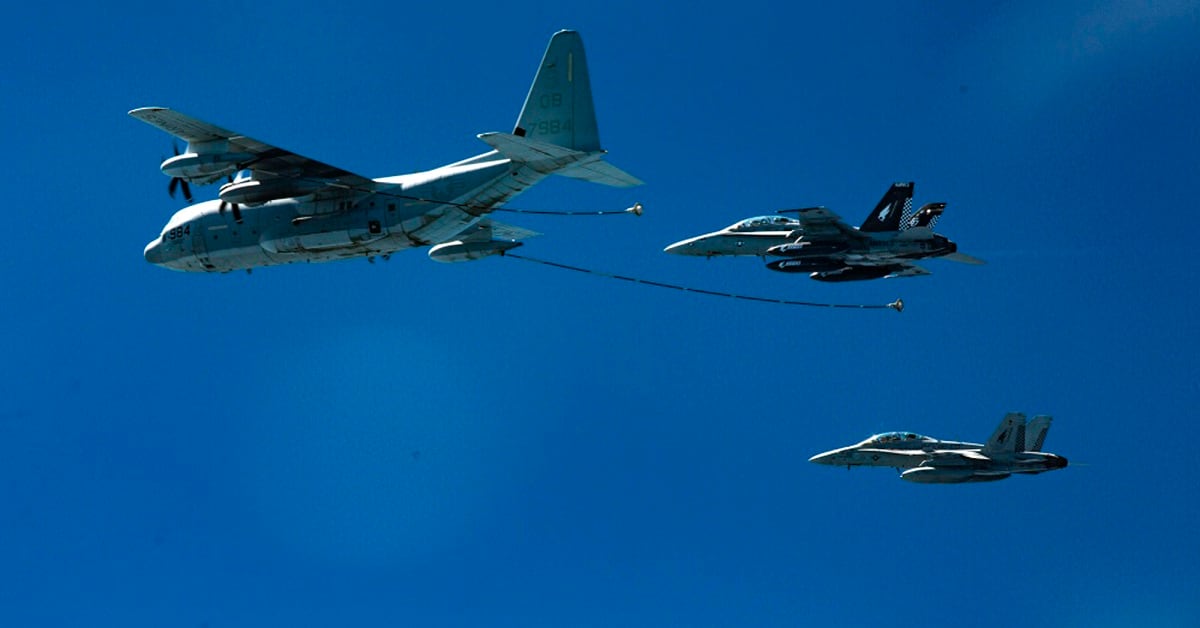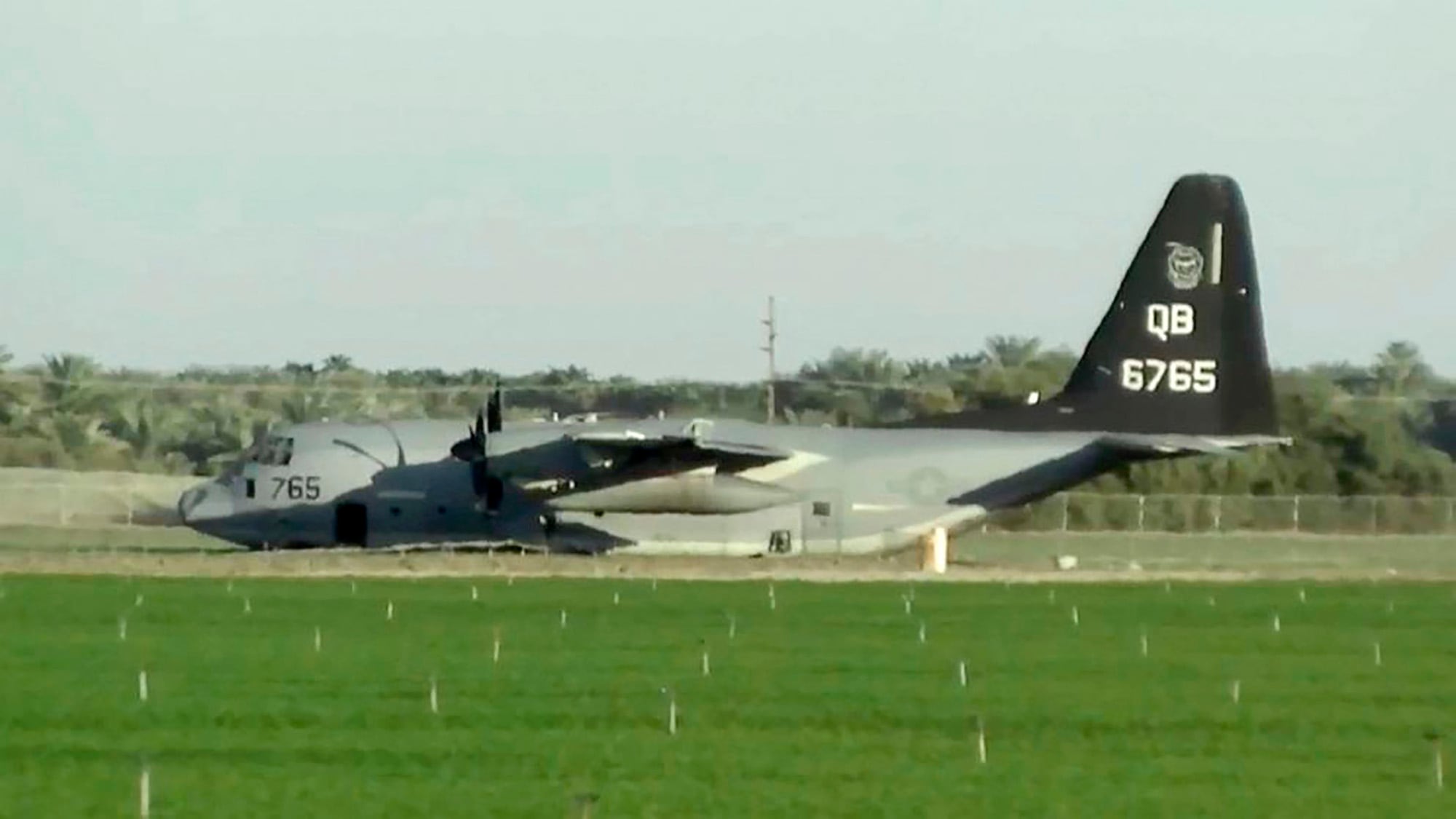A Marine major was piloting a KC-130J on a routine refueling mission on Sept. 29, 2020, when suddenly his nightmare came to life as an F-35B collided with his tanker.
“I did not expect to be able to fly the aircraft away from this situation because there haven’t been any successful midair collision with a C-130, that I know of, in which the crew survives,” Maj. Cory Jones said in a video released by the 2nd Marine Air Wing.
But after 12 minutes of fighting the damaged aircraft, Jones had done the impossible and safely landed in a farmer’s field ― keeping the other seven Marines aboard alive.
On Feb. 28, Jones, a pilot with the Fleet Replacement Detachment, 2nd Marine Air Wing based out of Marine Corps Air Station, Cherry Point, North Carolina, was awarded the Distinguished Flying Cross medal, the U.S.’s fourth highest award for bravery.
RELATED

‘Maybe we have a chance here’
Jones’ plane was providing support for the seven-week Weapons and Tactics Instructors Course conducted out of Marine Corps Air Station Yuma, Arizona, on that terrifying day.
He had just come off paternity leave and the flight was meant to help him knock off some rust, he said.
With a warning call from the aircraft’s right window observer that the F-35B was about to make impact, Jones knew it was not going to be a routine day.
“From the time he made his initial call to the aircraft hitting us was 1.2 seconds,” Jones said in the video.
Jones said he had lost multiple friends in two prior fatal KC-130 crashes, and that he often wondered what had gone through their heads in their final moments.
In 2017 a KC-130T crashed when its propeller came lose and flew into the body of the aircraft. The crash killed 15 Marines and a sailor.
In December 2018 a KC-130J crashed into the Pacific Ocean after colliding with an F/A-18 attempting to refuel during a routine night training mission.
Six Marines died in the incident, including all five C-130J crewmembers and the pilot of the F/A-18.
This time, the sudden warning immediately followed by massive impact did not give Jones time to think.
“There wasn’t any time to comprehend. The immediate thought was, ‘I can’t believe this is happening to me.’”
The pilot of the F-35B was able to eject safely, but Jones and the other seven members of the crew were left in their aircraft assuming they soon would die.
The impact’s violence knocked off his headsets and his hands off the control, Jones said.
When he finally was able to regain his grip, Jones realized he was able to have some control of the plane, despite two engines out and leaking fuel.
“That was the shock moment, like ‘OK, maybe we have a chance here,’” Jones said.
His mind then moved away from his wife, newborn son and lost friends to the task of saving his crew.
The crew of eight only had five parachutes, so the only option was landing the plane.
When asked about the number of parachutes, Marine spokesman 1st Lt. Duane Kampa said mission sets have different standard operating procedures based on assessed risk.
“The crew of Raider 50 was in full compliance with their squadron’s established Standard Operating Procedures for this mission, fixed-wing air-to-air refueling,” he told Marine Corps Times in a Thursday email.
Marine Corps Times also has requested the investigation into the incident, which has been completed but is “not available for public release,” Kampa said.
The Marine said the crew was dealing with an unprecedented number of catastrophic events, but was able to make it through due to training and the ability to calmly work as a team.
“We have to do whatever we can to get this plane on the ground,” Jones said.
Three other Marines who were part of the KC-130Js crew are pending awards for their actions that day, Kampa said.
“We will be able to provide more information following their award ceremonies,” Kamp said in an email to Marine Corps Times.
“In addition, the entire crew was awarded the James Maguire Award, an annual Marine Corps Aviation Award, for exceptional achievement,” Kampa added.
RELATED

During the 12 minutes after the midair collision, Jones piloted the KC-130J toward a small airport in Thermal, California.
But as system errors kept coming, the pilot and crew quickly realized the airport simply was too far.
“There was no way for us to continue our approach to that airport,” Jones said.
“The aircraft made an uncontrolled right turn due to getting into below our minimum control airspeed, and at that time we found the field straight off the nose of the aircraft and just decided to put down in the field.”




